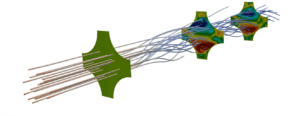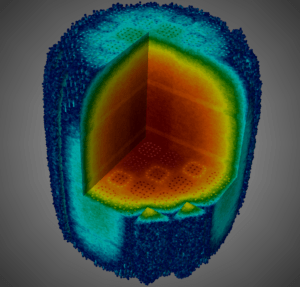Small modular reactors (SMRs) and advanced reactor concepts (ARCs) will deliver clean, flexible, reliable, and affordable electricity while avoiding the traditional limitations of large nuclear reactor designs, including high capital costs and long construction timelines. Current advanced reactor design approaches leverage decades of experimental and operational experience with the US nuclear fleet and are informed by calibrated numerical models of reactor phenomena. The exascale SMR (ExaSMR) project will generate virtual reactor simulation datasets with high-fidelity, coupled physics models for reactor phenomena that are truly predictive, filling in crucial gaps in experimental and operational reactor data. The ExaSMR virtual designs can accelerate the currently cumbersome advanced reactor concept-to-design-to-build cycle that has constrained the nuclear energy industry for decades. ExaSMR can also provide an avenue for validating existing industry design and regulatory tools.
Summary
Nuclear power reactors are an important part of a strategy to reduce greenhouse gases and achieve a carbon-neutral society, but they require extensive time and money to design and build. High-performance computing, however, can help accelerate the design of future reactors.
The next generation of supercomputers can help predict behavior inside the next generation of reactors, helping engineers and reactor designers see how they would behave, how much fuel they would need, how long the cycles last, and more. Such simulation can provide valuable information in months that otherwise would take many years of experimentation.
The Exascale Computing Project’s Small Modular Reactor (ExaSMR) project has developed the first of its kind simulations of advanced nuclear reactors, including small modular reactors and others, such as molten salt reactors and microreactors. This advanced software suite developed for exascale computing over the past seven years may help create the next generation of nuclear power generation in the United States.
With high confidence predictions and high resolution simulations, reactor companies don’t have to run as many experiments, which are time consuming and costly. The Exascale codes provide the means to see what the experiments would show, but more quickly and more accurately, than what has been available previously. This can reduce the lead time from concept to construction of a prototype, which also saves money. Previous simulation campaigns have been limited by the large computing power necessary to perform detailed reactor simulations. The ExaSMR code team had to rewrite new algorithms that enable it to run efficiently on the Frontier supercomputer. The result is that these codes can help reduce dependence on physical experiments because they are more accurate and predictive.
The project performed simulations involving both neutron transport and fluid dynamics. Neutron transport describes how neutrons move around a reactor and cause fission events, producing the heat that drives a power reactor. Fluid dynamics describes how the coolant moves through the reactor, transferring heat from the solid fuel to the liquid coolant. The ExaSMR team performed the largest reactor simulation ever, involving the simulation of more than 1 trillion neutron histories within the neutron transport solver and solving for more than 1 billion spatial regions in the fluid solver. The demonstration calculation achieved 100 times the computational performance that was demonstrated for the neutron transport solver just seven years earlier, and more than 400 times the performance for the fluid dynamics calculation. For this simulation, the code developers were named finalists for the Association for Computing Machinery’s Gordon Bell Prize for outstanding achievement in high-performance computing.
The tools enabled by the supercomputer are for demonstration purposes, but private companies are looking at the ExaSMR results for possible use in design of new reactors. The code could be useful for a variety of reactor types, including molten salt and pebble bed reactors that the U.S. Department of Energy and Nuclear Regulatory Commission have under consideration. Exascale computing could allow them to optimize designs to accelerate the advanced reactor concept-to-design-to-build cycle that has constrained the nuclear energy industry for decades.
Technical Discussion
ExaSMR integrates the most reliable and high- confidence numerical methods for modeling operational reactors: the reactor’s neutron distribution with Monte Carlo (MC) transport and the reactor’s thermal fluid heat transfer efficiency with high-resolution computational fluid dynamics (CFD)—and all for efficient execution on exascale systems. ExaSMR builds on a base of simulation applications that have demonstrated high efficiency on current petascale-class leadership computing systems. The ExaSMR effort also provides value to US nuclear fuel providers and the broader nuclear community through the generation of highly detailed virtual datasets of operational and advanced concept nuclear reactors. Although ExaSMR is nominally focused on SMRs, the majority of the approaches are generic and have the potential to impact a wide range of reactor designs from microreactors to existing commercial reactors.
ExaSMR’s exascale challenge problem will open the door to high-confidence prediction of reactor conditions, including low-power conditions at startup via the initiation of natural circulation of the coolant flow through a small modular reactor core and its primary heat exchanger. The exascale software orchestrating this simulation, known as ENRICO, ensures intimate coupling of CFD (NekRS) and MC neutron transport modules through a common interface that supports multiple exascale simulation technologies: one targeting the exascale Frontier architecture at ORNL (Shift) and another targeting the exascale Aurora system at Argonne National Laboratory (OpenMC).
Exascale neutron transport simulations for ExaSMR will accommodate a full-core SMR model, which typically has ~40 fuel assemblies (each with ~300 fuel rods). The MC portion of the simulation will simulate over 10B particles per eigenvalue iteration with pin-resolved reaction rates having 3 radial tally regions and 20 axial levels. Within each spatial region, reaction rates for several different reaction channels in each of more than 200 isotopes will be computed. These calculations will exceed the size of any previous known simulations by a substantial factor.
Exascale CFD requirements for ExaSMR will include a full-core mesh assembly bundle mesh models with at least 40M spatial elements and 22B degrees of freedom, including assembly bundle mesh models with momentum sources from representative resolved spacer grid simulations.
Software products
- NekRS: https://github.com/Nek5000/nekRS
- Shift: https://code-int.ornl.gov/rnsd/scale (ORNL internal)
- OpenMC: https://github.com/openmc-dev/openmc
- ENRICO: https://github.com/enrico-dev/enrico




